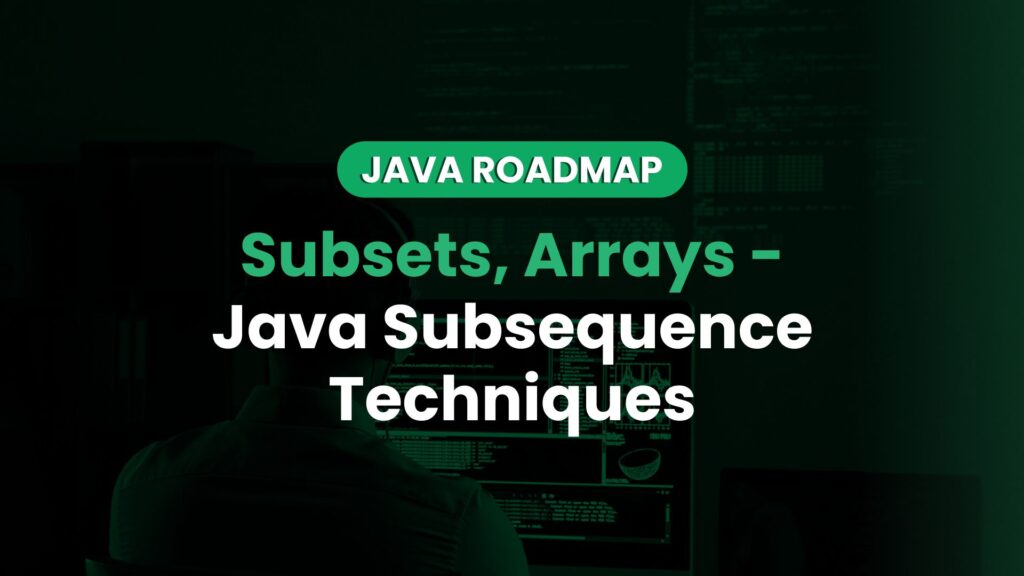Introduction
Data structures and algorithms form the foundation of computer programming, and mastering them is crucial for every programmer. In this article, we explore four important concepts in Java: Subarrays, Prefix Arrays, Subsets, and Subsequences. We will define each term, explain its significance, and provide Java examples along with practical use-cases.
Subarrays
A subarray is a contiguous part of an array of Java. In other words, an array that is a segment or a subset of another array is a subarray.
Example:
Consider an array a = {1, 2, 3, 4, 5}. The subarrays of this array include {1, 2}, {2, 3, 4}, and {4, 5}, among others.
Java Implementation:
The following Java code prints all the subarrays of a given array.
int[] array = {1, 2, 3, 4, 5};
for(int i=0; i<array.length; i++){
for(int j=i; j<array.length; j++){
for(int k=i; k<=j; k++){
System.out.print(array[k] + " ");
}
System.out.println();
}
}Use Case:
Subarrays find applications in many algorithm problems. For instance, the “maximum subarray problem” seeks to find the contiguous subarray within a one-dimensional array of numbers that has the largest sum.
Prefix Arrays
A prefix array is derived from another array such that the value at any index i in the prefix array is the sum of all the numbers in the original array from the start up to index i.
Example:
If you have an array a = {1, 2, 3, 4, 5}, the prefix array would be {1, 3, 6, 10, 15}.
Java Implementation:
The following Java code generates a prefix array from the given array.
int[] array = {1, 2, 3, 4, 5};
int[] prefixArray = new int[array.length];
prefixArray[0] = array[0];
for(int i=1; i<array.length; i++){
prefixArray[i] = prefixArray[i-1] + array[i];
}
// Now prefixArray is {1, 3, 6, 10, 15}Use Case:
Prefix arrays are useful in scenarios where we frequently need to compute the sum of elements within a certain range in an array. With a prefix array, we can find this sum in constant time, which significantly boosts efficiency.
Subsets
A subset of a set (or in this case, an array or list) is a set that contains elements from the original set. A set of n elements has 2^n subsets (including the empty set and the set itself).
Example:
The subsets of the set {1, 2} are {}, {1}, {2}, and {1, 2}.
Java Implementation:
Here is a Java program that generates and prints all the subsets of a given set.
void printSubsets(char set[])
{
int n = set.length;
for (int i = 0; i < (1<<n); i++)
{
System.out.print("{ ");
for (int j = 0; j < n; j++)
if ((i & (1 << j)) > 0)
System.out.print(set[j] + " ");
System.out.println("}");
}
}Use Case:
Subsets are often used in combinatorial problems and in the implementation of certain algorithms, such as backtracking and dynamic programming.
Subsequences
A subsequence is a sequence that can be derived from another sequence by deleting some or no elements without changing the order of the remaining elements.
Example:
The array {1, 3} is a subsequence of the array {1, 2, 3}.
Java Implementation:
The following Java function generates and prints all subsequences of a given array.
public static void printSubsequences(int[] arr, int index, ArrayList<Integer> path) {
if(index == arr.length) {
System.out.println(path);
return;
}
// We select the element
path.add(arr[index]);
printSubsequences(arr, index + 1, path);
path.remove(path.size() - 1);
// We do not select the element
printSubsequences(arr, index + 1, path);
}Use Case:
Subsequences are instrumental in various dynamic programming problems and problems related to string or sequence manipulation.
Conclusion
Understanding the nuances of these four concepts – subarrays, prefix arrays, subsets, and subsequences – is key to mastering Java and improving your algorithmic problem-solving skills. Practice these concepts with varied examples and real-world scenarios to build a strong foundation. Happy Coding!

